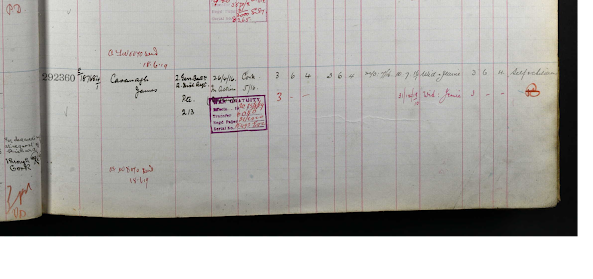While a number of improvised armoured cars were constructed during the Easter Rising using lorries from Guinness and steel plate from the Inchicore rail works, and several Rolls-Royce armoured cars arrived in Ireland just after the Rising, tanks were still too new (and secret) to make an appearance in Ireland. The arrival of the 17th (Armoured Car) Battalion of the Tank Corps in January 1919 is reasonably well documented/photographed with a mixture of Mark IV, Mark V* and Whippet tanks and Austin armoured cars.
In November 1917, however, a Mark IV tank appears to have been in Dublin operating at the RDS in Ballsbridge while a host of other Mark IV tanks were preparing for the Battle of Cambrai (and two for the Lord Mayor's Show in London). There is some irony here as County Dublin born Walter Wilson was heavily involved in the design work.
There was a reference to a tank in Dublin pre 1919 mentioned on a thread on the Great War Forum many years ago and a reference to this being filmed in the blog on Early Irish Cinema (and to cameraman John Gordon Lewis) by Derek Condon (@DenisCondon on Twitter) :
https://earlyirishcinema.com/category/films/topicals/tanks-in-dublin-ireland-gfs-1917/
The Freeman's Journal carried a news item that month re the film that Lewis had taken :
The head on image is blurry but the number 42 can be made out on the front slope of the tank. Not standard number format for the tanks and not quite sure what it means.
Lewis's offices were raided by anti-treaty Republicans and it was believed that his film of the event was lost. A visit to the National Archives in Dublin re the file containing Lewis's claim for damage didn't reveal any more information sadly.
However, a post on Twitter by @ThisDayInWWI with a video of a tank looked familiar. Sure enough, the number 42 appears on the front of the tank, the head on view matches the image from the Freeman's Journal, and there appear to be horses in the background (the RDS in the Ballsbridge area of Dublin being used as a staging point for horses going to the Army).
The film is hosted on the Imperial War Museum (IWM) website (catalogue number IWM 1196) and carries the somewhat unhelpful title :
"TANKS MARK IV, SCHNEIDER, AND MARK IV UNDITCHING [Allocated Title]"
https://www.iwm.org.uk/collections/item/object/1060000185
The film is made up of a number of different clips. The one related to Lewis's filming runs from 00:00 to 02:55 so not a lot of footage but enough to spark interest (and possibly meaning that there is more out there somewhere - e.g. the top photo in the Journal article doesn't match in the clip).
Tank 42 appears in this second clip on the IWM site (catalogue number IWM 1198) from about 11:15. The background from 11:22 looks to be the same as the above clip so possibly the RDS too
https://www.iwm.org.uk/collections/item/object/1060000187
It would appear that there was concern in England that trouble was brewing in Ireland following the death of Thomas Ashe, the Sinn Fein Convention etc and that 4 tanks in a Special Service Unit were sent across from Bovington as a potential show of force - 2 kept in Dublin, 1 sen to Cork, 1 sent to Limerick. (Updated 20th October 2024)
As well as having the first tank in Dublin in November 1917, the first Tank Corps death happened too.
Captain Leonard Bates MC was killed while a tank was being unloaded at the RDS in Ballsbridge, Dublin.
Present at the inquest were 2 members of the Tank Corps :
Sgt William Quincey Jeffs appears to have been a Sergeant instructor while Lt Thomas Frederick Murphy appears to have been a wounded officer recovering from burns. Murphy and Bates had both been commissioned into the Machine Gun Corps from the 18th (Service) Battalion, Royal Fusiliers in early 1916, both having qualified as machine gunners.
Captain Bates is buried in Grangegorman Cemetery in Dublin.
https://www.cwgc.org/find-records/find-war-dead/casualty-details/899811/leonard-john-bates/
Clips from the film appear in other films on the IWM site :
The US troops section of the film is labelled 356-2 and this can be seen in the Topical Budget 356-2 film on the IWM site (catalogue number NTB 356-2) at approx 3:47 on the timeline :
https://www.iwm.org.uk/collections/item/object/1060005457
Several of the clips appear in the film on the IWM site (catalogue number IWM 337) titled "Tanks The Wonder Weapon" :
https://www.iwm.org.uk/collections/item/object/1060022815
Links to previous related posts :
Henry Deasy (and armouring the Guinness lorries)
17th (Armoured Car) Battalion, Tank Corps
Victory Parade Dublin July 1919




.png)












